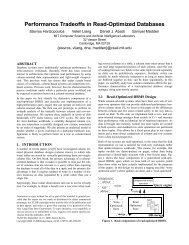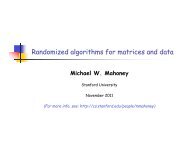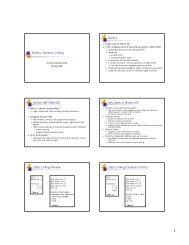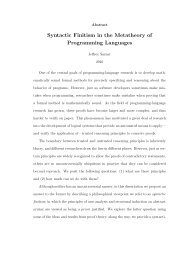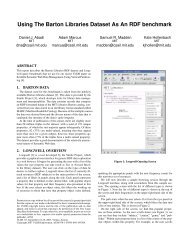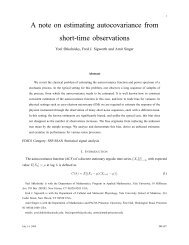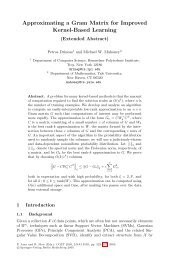PRAM Algorithms Parallel Random Access Machine ... - Washington
PRAM Algorithms Parallel Random Access Machine ... - Washington
PRAM Algorithms Parallel Random Access Machine ... - Washington
You also want an ePaper? Increase the reach of your titles
YUMPU automatically turns print PDFs into web optimized ePapers that Google loves.
Pointer Jumping Example Analysis<br />
Find roots –CREW vs. EREW<br />
How fast can n nodes in a forest determine their<br />
roots using only exclusive read?<br />
Ω(lg n)<br />
Argument: when exclusive read, a given peace of information can only be<br />
copied to one other memory location in each step, thus the number of locations<br />
containing a given piece of information at most doubles at each step. Looking<br />
at a forest with one tree of n nodes, the root identity is stored in one place initially.<br />
After the first step, it is stored in at most two places; after the second step, it is<br />
Stored in at most four places, …, so need lg n steps for it to be stored at n places.<br />
So CREW: O(lg d) and EREW: Ω(lg n).<br />
If d=2 o(lg n) , CREW outperforms any EREW algorithm.<br />
If d=Θ(lg n), then CREW runs in O(lg lg n), and EREW is<br />
much slower.<br />
Using Euler Tours<br />
Trees = balanced parentheses<br />
Parentheses subsequence corresponding to a subtree is balanced<br />
Parenthesis version: ( ( ) ( ( ) ( ) ) )<br />
Complexity measures:<br />
What is W(n)?<br />
What is S(n)?<br />
Termination detection: When do we stop?<br />
All the writes are exclusive<br />
But the read in line 7 is concurrent, since several nodes<br />
may have same node as parent.<br />
Euler Tours<br />
Technique for fast processing of tree data<br />
Euler circuit of directed graph:<br />
Directed cycle that traverses each edge exactly once<br />
Represent tree by Euler circuit of its directed version<br />
Input:<br />
Depth of tree vertices<br />
L[i] = position of incoming edge into i in euler tour<br />
R[i] = position of outgoing edge from i in euler tour<br />
forall i in 1..n {<br />
A[L[i]] = 1;<br />
A[R[i]] = -1;<br />
}<br />
B = EXCL-SCAN(A, “+”);<br />
forall i in 1..n<br />
Depth[i] = B[L[i]];<br />
Parenthesis version: ( ( ) ( ( ) ( ) ) )<br />
Scan input: 1 1 -1 1 1 -1 1 -1 -1 -1<br />
Scan output: 0 1 2 1 2 3 2 3 2 1<br />
7



